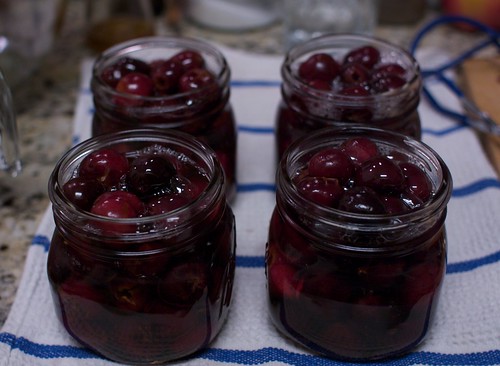
Prepared Jars by Don Feduardo
All photos courtesy of the author
We Love Drinks embarks on a series where we attempt to make our favorite cocktails and essential drinks ingredients from around town. If there’s something you’d like us to feature, please let us know!
The proper garnish is a critical part of some cocktails. DC has no shortage of bars where you can get a craft cocktail, and if you watch the bartenders at work at one of these establishments (and I have) you can see (and taste) how the garnish really can finish a drink, either emphasizing or complementing certain flavors in the liquid ingredients.
My first craft cocktail experience in the area came at PX, where the craft most definitely extends to the garnish. One of the cocktails I had on my first visit was listed on the menu as not just a Manhattan, but “My Wife’s Manhattan.” How could I pass that up? So I was very pleased when the Washington Post ran the recipe for Todd Thrasher’s preserved cherries. I made my first batch of them as soon as I could round up a cherry pitter and some cherries, based on the vagaries of supply and demand at Giant. And they were good, but they were salty. I had done something wrong.
It didn’t matter that they were too salty, though, because the Social Chair and I polished them off with some dispatch. We had three problems, really: 1) that first batch was too salty; 2) supply is unpredictable and the cherry season is short; 3) the recipe says they’ll last for two weeks in the fridge, nowhere near as long as our own Manhattan season. So I decided the next batch would solve all three of those problems. We bought a supply of Mason jars and an unreasonable quantity of cherries, and I read up on water bath canning. A couple years and about thirty pounds of cherries later (relax, we give them as gifts) later, I’ve got this process down.
For convenience, here’s that recipe again:
Ingredients:
2 pints bing cherries
1 1/2 cups water
1 tablespoon salt
2 1/4 cups sugar
Juice of 1 medium lemon
1 tablespoon almond extract
Step Zero: In addition to those ingredients you will need a large pot and jars and new lids (about one pint jar per pound of fresh cherries, plus one extra for overflow). When I started canning I wanted neither to buy a new pot for canning nor to find a place to store it in my small kitchen, so I used the stockpot I already had and lined the bottom of it with extra Mason jar rings. If you have the room you can get a canner and rack, but I still make do with my improvised solution.
I feel like a cherry pitter pays for itself, but if you can’t stand the idea of adding a unitasker to your kitchen, you can always just use a paper clip (it’s a good thing). You can find almond extract in the spice aisle, or order it from a specialty food shop. You can get by without a full set of canning tools, but they’re cheap and worth it for the jar grabber alone.
One: Wash your cherries, then pit them and remove the stems. If you’re using a pitter, load the cherry in upside down so the stem points through the hole in the pitter, and (in most cases) the pit and stem will come out together, cleanly.
Don’t do this while wearing white clothes or near anything you don’t want stained, as there will be little specks of cherry juice everywhere. Place the cherries in a shallow heatproof glass or ceramic bowl.
Two: In a medium saucepan over high heat, combine 1 1/4 cups of the water and the salt. [NB: if you scale this recipe up, don’t scale the salt up quite as much as everything else. I use about 2 tablespoons in four cups of water]. Bring to a boil, stirring until the salt has dissolved. Remove from the heat; allow to cool for 10 minutes, then pour the liquid over the cherries. Cover and refrigerate overnight.
Three: Drain the cherries, discarding the liquid. Fill the bowl with fresh, cold water and stir the cherries around gently with your hand. Discard the rinse water. Repeat this rinsing step.
Taste a cherry. If it still tastes strongly of salt, repeat the rinse one more time. Drain the cherries in a strainer, shaking the strainer gently to release as much water as possible. Wash the bowl in which the cherries were refrigerated and return them to the clean bowl. Set aside.
Four: Prepare your jars and lids following manufacturer and USDA (or grandma) guidelines. I didn’t learn at my grandmother’s side, so I follow the more cautious guidelines set out by the USDA. Fill your canner (or ring-lined stockpot) with water, up to about two inches below the top, and bring to a rolling boil. While waiting, proceed to step five. And please, if you find any discrepancies between the guidelines (which are updated periodically) and what you read here, follow those guidelines instead.
Five: In a small saucepan over medium-high heat, combine the sugar, lemon juice and remaining 1/4 cup of water [This is a heavy syrup, and I usually cut back on the sugar slightly; if you’re unsure on the lemon juice, a little extra won’t hurt]. Bring to a boil, stirring to dissolve the sugar, then remove from the heat and add the almond extract. Pour the mixture over the cherries and stir gently to mix.
Six: At this point you will have four pots on your stove (one with sterilized jars, one with lids, the stockpot or canner, and one saucepan containing the syrup).
One by one, remove a sterilized jar, drain, and fill with the cherry/syrup mixture, up to the shoulder of the jar. Don’t overfill, or the seal will fail. Use a non-metallic spatula to remove any large air bubbles, top off the jar with syrup if necessary, then wipe any syrup from the rim of the jar and apply the lid and band following manufacturer guidelines. Place the jar into the canning rack or carefully lower it into the pot of boiling water. Repeat until your pot won’t hold more jars, or you have run out of cherries. My stockpot holds four wide-mouth jars.
Seven: Once your canner/stockpot is full or your cherries have run out, return it to a rolling boil. Once boiling, process the cherries for 20 minutes.
Eight: To avoid temperature shock, you’re supposed to turn off the heat and allow the jars and water to cool for ten minutes. I’ve never done this. Carefully remove the jars (keeping them as level as possible) and place them on a rack or towel to cool. Allow them to sit undisturbed for 12-24 hours so the lids form a tight seal, then check the seals on every jar.
Nine: If any jars failed to seal, you can reheat the cherries and process them again, or just commit to consuming those within two weeks. Otherwise label the jars with the date they were processed. According to guidelines, they’re good for a year.
Ten: Enjoy! I first enjoyed these in a Manhattan, so here’s my own take, adapted from the Jerry Thomas original, via Gary Regan:
I’ll Take [a] Manhattan:
2 oz Bourbon (I regularly use Evan Williams Black Label)
1 oz sweet Vermouth (Noilly-Prat is my standard bottling)
.25 oz Luxardo Maraschino liqueur
Two dashes Peychaud’s bitters
Three dashes Regan’s Orange Bitters No. 6.
[All those, including the bitters, are available at Calvert Woodley, whose staff first recommended the Evan Williams to me. I have no connection with them except as a paying customer.]
Combine all ingredients in a mixing glass, stir with ice for at least 45 seconds, then strain into a chilled cocktail glass or champagne coupe. Garnish with a cherry.
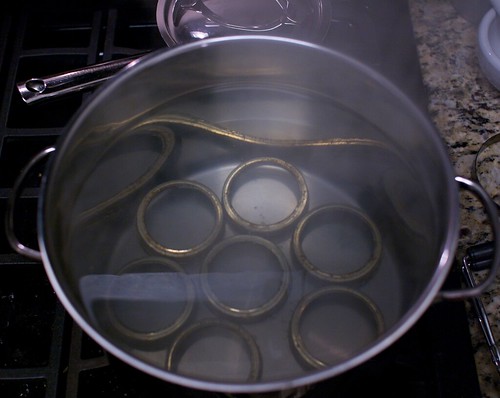
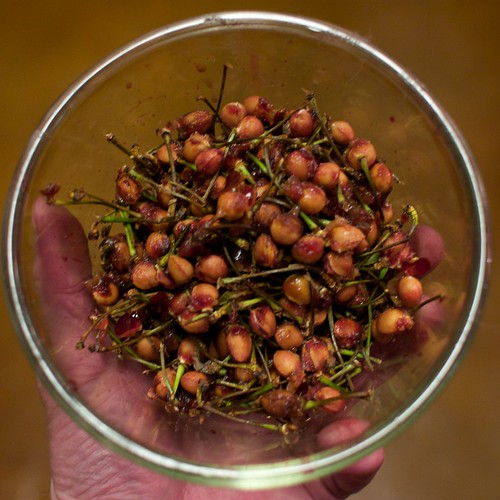
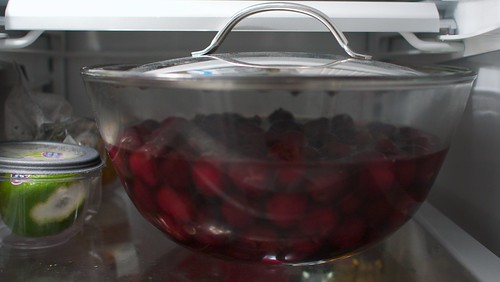
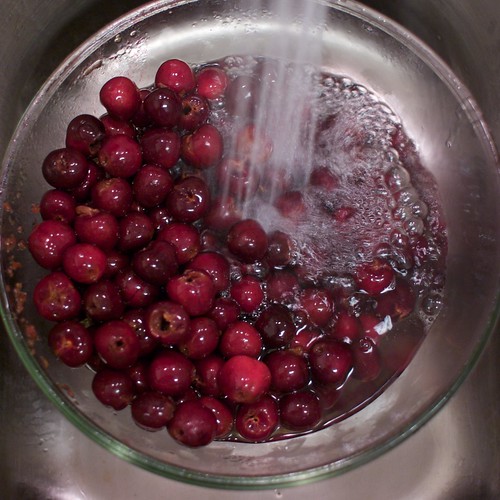
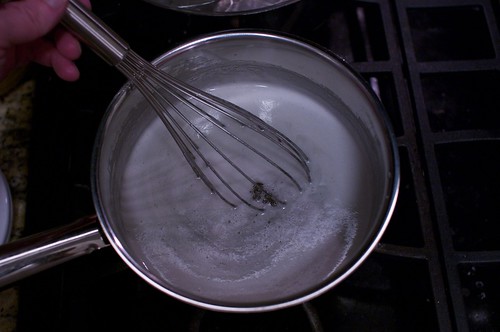
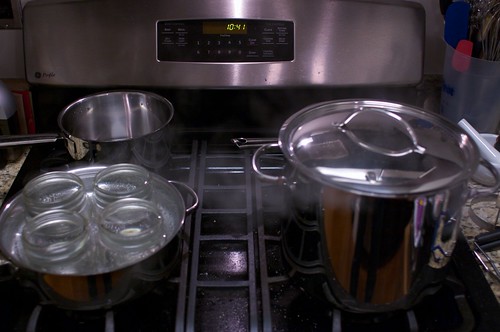
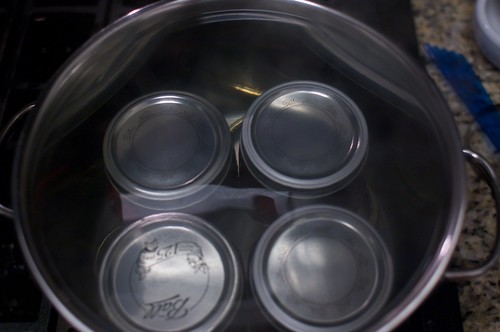
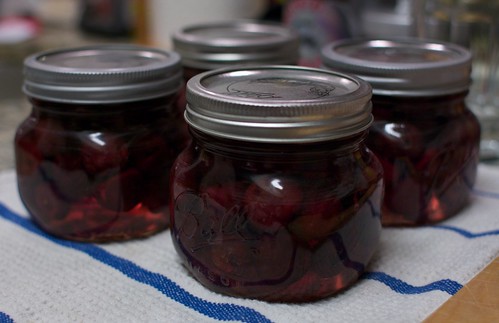


Pingback: Tweets that mention We Love Drinks: Todd Thrasher’s Preserved Cherries » We Love DC -- Topsy.com
Two warnings:
1) Once you have these, you will not want regular maraschino cherries.
2) Once you give a jar to friends, THEY won’t want regular maraschino cherries.
Pingback: Good Spirits News 2.14.11 « Good Spirits News